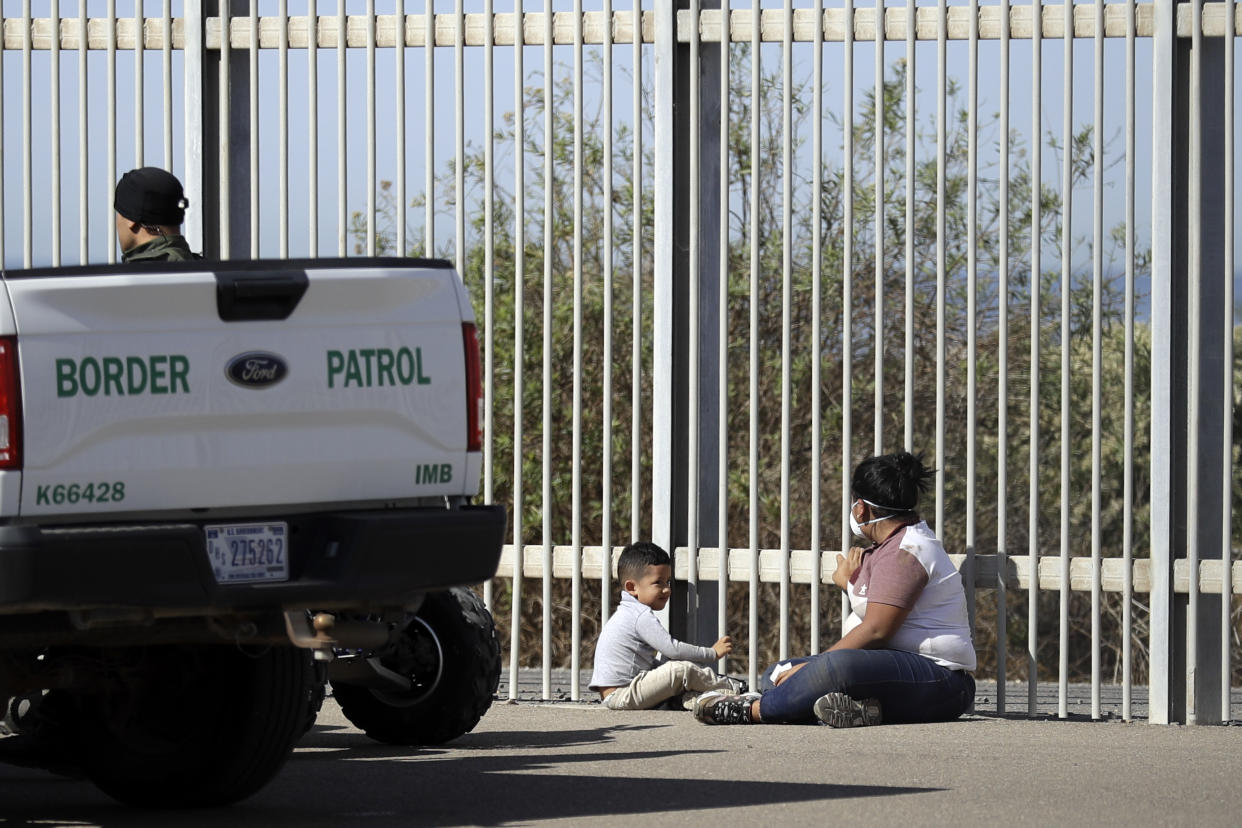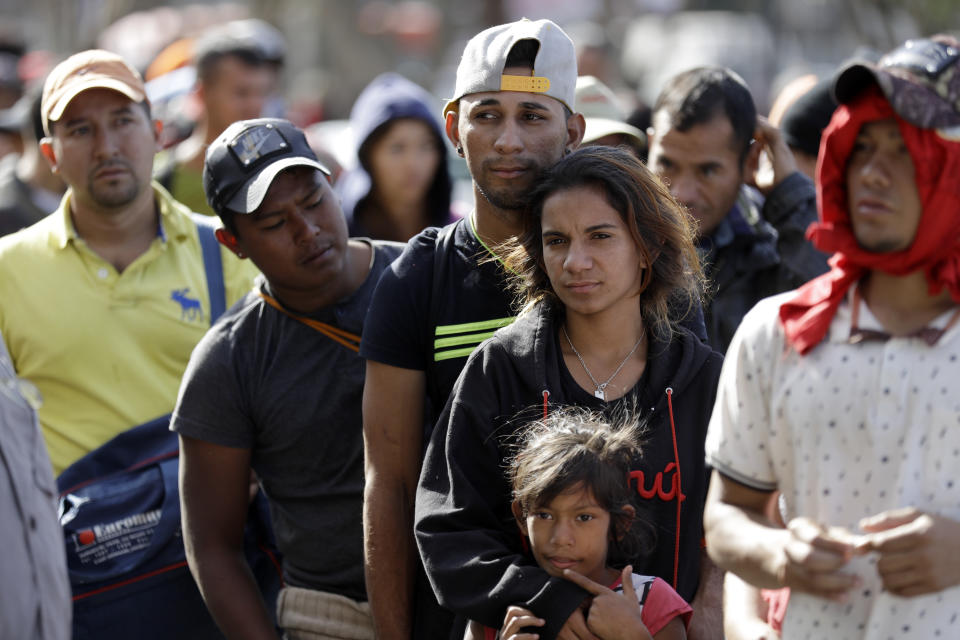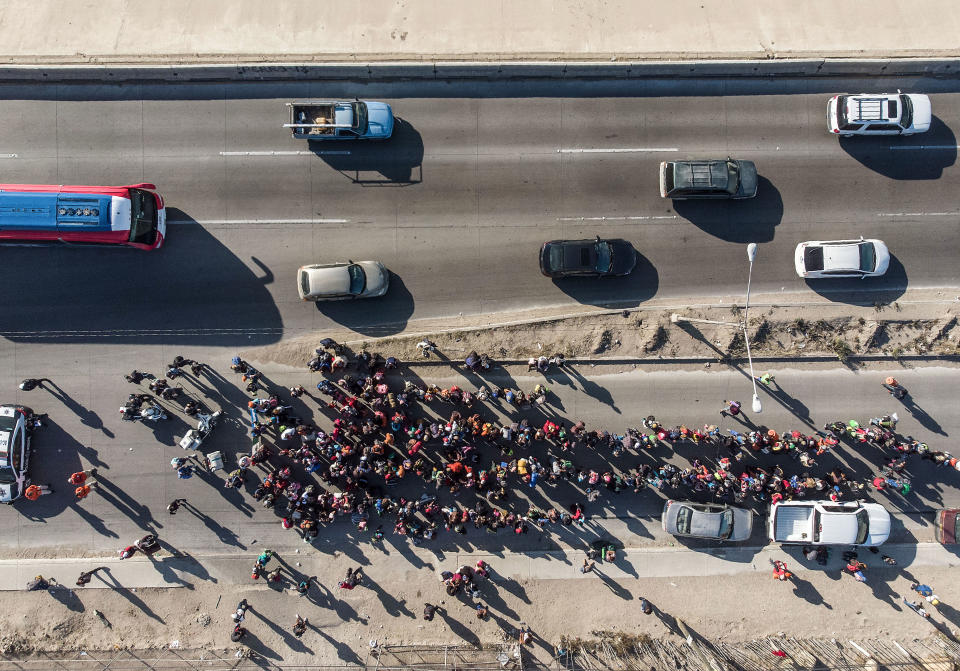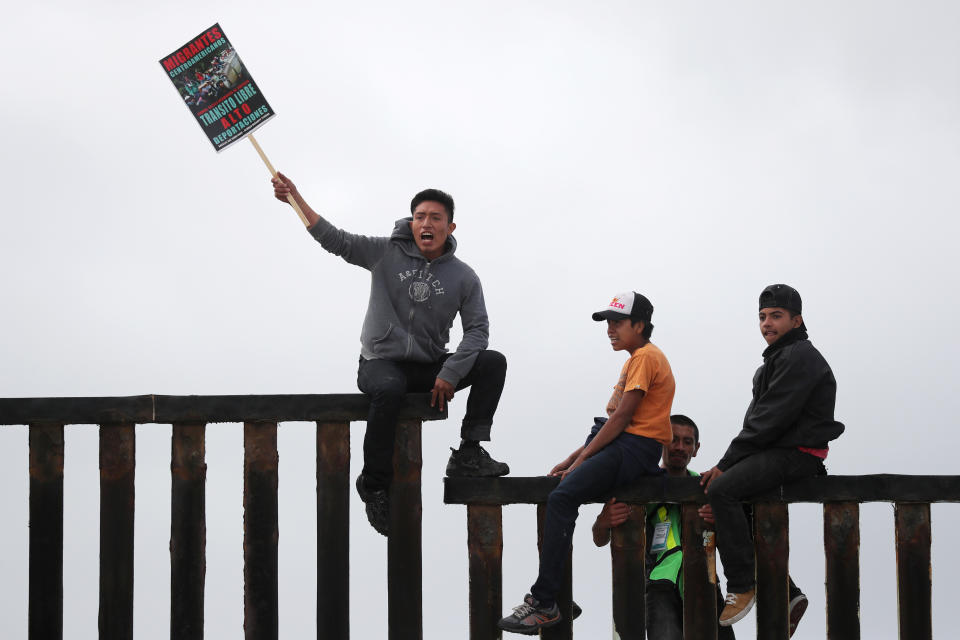Advance guard of caravan reaches U.S. border — and waits

Migrants traveling through Mexico as part of highly publicized — and highly politicized — caravans finally began to arrive in Tijuana by the hundreds last week, reaching what many hope will be the last stop on a long and arduous pilgrimage that began in Honduras more than a month ago.
“Where I want to go is the United States of America,” Cesar, 23-year-old asylum seeker from Honduras, told Yahoo News over the phone from a shelter in Tijuana earlier in the week. Cesar, who asked to be identified by his first name because of safety concerns, is one of nearly 80 gay, lesbian, bisexual and trans migrants who arrived in Tijuana over the weekend after breaking off from the larger caravan during a rest period in Mexico City last week.
Though it’s less than 20 miles from San Diego, Tijuana hardly marks the end but rather the beginning of a new phase along this journey north for Cesar and others who hope to seek asylum in the U.S. — a process the Trump administration has recently acted to restrict ahead of the caravan’s highly anticipated arrival. With U.S. border officials processing only about 100 asylum applications per day at the major port of entry to San Diego, migrants from the caravan who want to seek asylum in the U.S. are expected to wait weeks or even months in Mexico.
Well before Trump signed a presidential proclamation banning access to asylum for anyone who crosses the border between ports of entry — a legal and common practice, particularly among Central Americans seeking refuge in the U.S. — U.S. Customs and Border Protection had already enlisted the help of Mexican government officials and nongovernmental organizations on the ground in Tijuana to help them impose daily limits on the number of asylum seekers who can enter at the San Ysidro port of entry. San Ysidro is the busiest land border crossing in the Western Hemisphere; 70,000 vehicles and 20,000 pedestrians enter the U.S. here each day.
“CBP coordinates with the Government of Mexico, to advise them the number of spaces available for intake, and they coordinate with the NGOs to bring that number of asylum seekers to the port of entry,” a CBP spokesperson confirmed to Yahoo News. CBP insists that the daily limits are simply an organized way of dealing with capacity constraints at San Ysidro. Yet immigration attorneys and human rights advocates argue that the system, which forces migrants to wait in Mexico — sometimes for several weeks — before they can cross, is both illegal under international asylum law and a practice that is ripe for abuse.
“CBP is under legal obligation under U.S. and international law to inspect and process asylum seekers at our ports,” said Shaw Drake, policy counsel for the ACLU of Texas’s Border Rights Center. “Anytime someone appears, they should be immediately processed.”
Instead, migrants must first get their names on a list, which is reportedly handwritten on sheets of notebook paper in a binder controlled by another asylum seeker, who then provides them with a number which they must wait to be called.

Cesar and his LGBTQ cohorts had to wait five days in Tijuana before they were all able to get on the list , finally receiving their precious numbers on torn pieces of notebook paper on Thursday morning, just as more members of the caravan began to descend on Tijuana by the hundreds.
Cesar said knew he would have to “endure a lot of hunger, a lot of sun, a lot of rain” and a lot of walking on the path to the U.S., but he told Yahoo News that ultimately, he decided that whatever obstacles he may face by joining the caravan were greatly outweighed by the discrimination, abuse and daily threats of violence he faced as a gay man in Honduras. Once he’d been identified as gay, Cesar said, it was impossible to find work, adding that he’d even been denied entry to certain places like the supermarket because of his sexuality. Above all, Cesar said, he no longer felt safe in his home country, having become consumed each night with the thought that “in the morning, I could be assassinated.”
In Honduras, a country that consistently has among the highest murder rates in the world, gay, lesbian, bisexual and transgender people are particularly vulnerable to violent attacks that often go unpunished. Members of this population face similar dangers in El Salvador and Guatemala, with “epidemic levels of violence” forcing large numbers of LGBTQ people to flee all three of these countries in recent years, according to Amnesty International. A study by the UNHCR found that, in 2016, 90 percent of LGBT refugees and asylum seekers from Central American reported that they were subjected to sexual and gender-based violence in their home countries.
While many in the caravan were traveling with parents or children, Cesar and many of the other LGBTQ migrants he encountered along the way had embarked on the journey alone. Pretty much all of them had fled discrimination and violence in their home countries only to face it on the journey, from residents of the towns they passed through and even other caravan members. Trans women in particular were subject to harassment — ranging from catcalls to threats from men in the caravan — and struggled to keep up with the rest of the caravan as they hitchhiked along the route to Mexico City, where many drivers refused to give them rides.
“Among the entire caravan … this group faced [the] additional challenge of being under continuing threat in Mexico due to their LGBTQ status, [including] online posting with threats of violence against them in particular,” said Jonathan Ryan, executive director of the nonprofit Refugee and Immigrant Center for Education and Legal Services, or RAICES.
Earlier this month, advocates with RAICES traveled to Mexico City, where the caravan had been offered shelter and a chance to rest inside a large stadium. There, they met Cesar and the other LGBTQ migrants traveling with caravan, and upon learning of the specific threats and discrimination they’d encountered along the journey, were prompted to secure transportation to help this group get to Tijuana before the rest of the caravan.

“Knowing that the capacity of any shelter or groups at border was going to be stretched, we determined that we wanted to follow with this group and protect them all the way until they hand themselves over and request asylum at border,” said Ryan.
Administration officials insist the new asylum restrictions will benefit people with “legitimate asylum claims” by weeding out those with fraudulent claims. The grounds for claiming asylum have been narrowed by the Trump administration, which moved to exclude refugees seeking to escape domestic violence or criminal gangs. Immigrant advocates contend that abuses of the system have been minor, and question whether CBP’s continued use of a “metering” system for asylum seekers at ports of entry like San Ysidro is meant to discourage even those with legitimate claims, such as religious or political discrimination.
“This does not appear to be a matter of capacity, but purposely understaffing and under-utilizing full capacity to create more of a crisis on the other side of the border, used to create a false and anti-immigrant narrative,” said Ryan of RAICES.
During a press briefing on the proclamation last week, officials indicated they had no plans to expand spatial or personnel capacity to process the inevitable influx of asylum seekers at ports of entry despite fact that they were now explicitly directing people — including members of the caravan — who want to seek asylum to do so at these designated locations.
However, last week the CBP announced the closure of several vehicle lanes at the San Ysidro and Otay Mesa ports of entry, which straddle the border between Tijuana and San Diego, to “prepare for the potential safety and security risk” the caravan’s arrival could cause.
“These preparations include training exercises, deploying additional CBP personnel, and partnering with the U.S. military to harden our ports of entry and the border area between those legal crossings into the U.S.,” Pete Flores, director of field operations in San Diego, said in press release, which also noted that Department of Defense personnel were being enlisted to install concertina wire, temporary traffic barriers and additional fencing.
“They could be addressing this problem in much more effective manner, [but the] bottom line is they don’t want to,” said the ACLU’s Drake. “They want the restrictions at the ports, want people to be forced to cross between ports where they’ve now tried to strip them to access of asylum status and [this] feeds into the narrative that border needs securing.”
Not all those marching in the caravan plan to seek asylum. One man who arrived in Tijuana as on Wednesday told the Associated Press he intended to hop the border fence with several others who were still on their way.
But whether the migrants who have already arrived and the thousands behind them are thwarted by a barbed-wire fence or stalled by an ad-hoc bureaucracy in the form of a handwritten list, the result may be the same: a potentially dangerous buildup of families and single men and women on the Mexican side of the border.
On Wednesday night, violent clashes reportedly broke out between local residents and migrants as hundreds of the first wave of caravan arrivals attempted to set up a makeshift camp on the beach. This prompted local officials to open a temporary shelter at the Benito Juarez sports complex, which can accommodate 3,000 people.

Less than a week after they got to Tijuana, Cesar and the others have already been forced to relocate once due to safety concerns. “In the past, shelters that have housed LGBTQ people in Mexico have been firebombed,” Ryan noted.
Cesar said he’d heard something about new restrictions being imposed at the border, which he said he thinks are driven by a false impression of the caravan’s intentions.
“We want to do things well; we do not want to enter as evil immigrants by the thousands,” he said.
As he waits for his number to be called, Cesar fantasizes about life on the other side of the border. The U.S. is a free country, he says, where he could live and work without fear of being attacked for who he is. There, he hopes to pursue his passion for cooking and go to school to become a chef. One day, he says, he could even get married.
One thing he knows for sure is he’s come too far to go back now, predicting that gangs and bad people “will be the first ones” looking for him if he’s forced to return home.
“I want to [cooperate] with American authorities,” he said, “because I can no longer live in Honduras.”
____
Read more from Yahoo News:
George Conway: Republican Party has become a ‘personality cult’ under Trump
An American killing: Why did the U.S. Park Police fatally shoot Bijan Ghaisar?
Cory Booker: I will ‘take some time over the coming months’ to consider 2020 bid
Hugh Jackman on ‘The Front Runner’: I told Gary Hart I took his legacy ‘very seriously’



